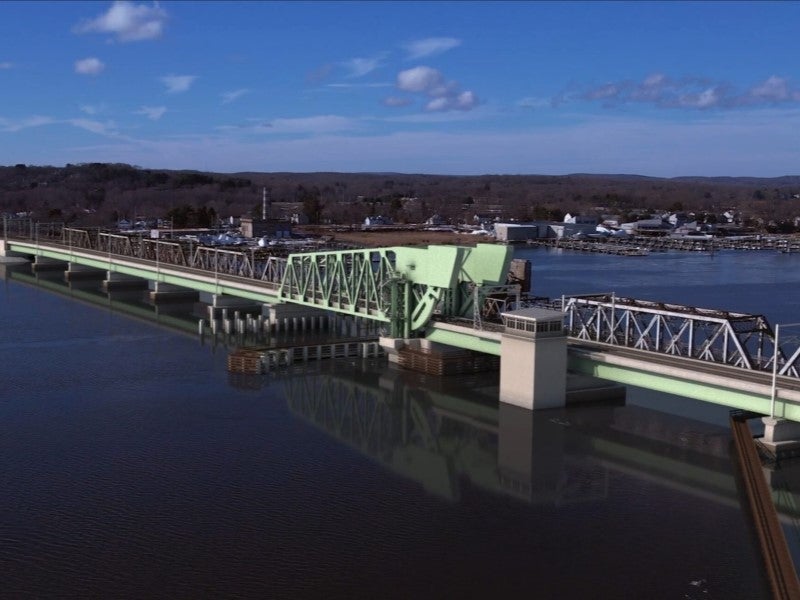The Connecticut River Bridge replacement project involves the construction of a new, electrified, two-track, movable bridge on the Connecticut River.
The new bridge will replace the existing 116-year-old two-track bridge that spans the Connecticut River between Old Saybrook and Old Lyme in Middlesex County, Connecticut, US.
The project is being developed by Amtrak, a publicly funded train service provider in the US. Various federal and state agencies are collaborating on the project, including the Connecticut Department of Transportation (CTDOT), the US Department of Transportation Federal Railroad Administration (FRA) and the Federal Transit Administration (FTA).
The construction on the $1.3bn project is slated to commence in late 2024, with an anticipated completion date in 2031.
The new bridge will address the bridge’s existing structural deficiencies and increase the vertical clearance. It will help in continuing rail services across the Connecticut River, enhancing reliability and reducing travel delays by facilitating higher train speeds.
Connecticut River Bridge replacement project background
Located approximately midway between New York and Providence, the 1,500ft (457.2m) long bridge was constructed in 1907. It is a pivotal segment of the Northeast Corridor (NEC), accommodating both passenger and freight train services.
With the bridge nearing the end of its usable lifespan, a new structure is essential to sustain future rail operations and to provide an improved navigational channel for maritime traffic on the river.
The two-track bridge is integral to the NEC mainline and supports Amtrak’s intercity services, the Connecticut Shore Line East commuter service, and various freight operators.
Amtrak together with local government entities and agencies concluded the project’s conceptual design phase in 2007, followed by the distribution of an environmental assessment for public and agency review in 2014.
In 2017, the FRA issued a Finding of No Significant Impact (FONSI), which allowed the project to advance to its final design and construction stages.
Connecticut River Bridge replacement project details
The project entails the construction of a new railway bridge, which will be situated 52ft south of the current bridge’s centreline. The new structure will not incorporate the existing piers, necessitating the creation of a new substructure. The work will be carried out within the confines of Amtrak’s current right-of-way (ROW).
The replacement bridge will provide a 204ft-long steel truss bascule movable span with improved navigational clearances in both closed and open positions. It will widen the navigation channel from its current width of 139ft to 150ft and will offer an increased vertical clearance of 24ft when closed, compared to the existing 18ft. When the bridge is open, it will provide unrestricted vertical clearance.
The number of spans will be decreased from ten to nine, featuring steel girder approach spans with a composite concrete deck. These spans will rest on concrete piers, which will be based on drilled shaft foundations or spread footings in areas where the rock elevation is not deep.
New embankments and retaining walls, constructed within Amtrak’s ROW, will support the east and west at-grade railroad approaches.
The bridge will be equipped with modern track, signal, catenary, power, communication, controls, and security systems. The anticipated lifespan of the new structure is 100 years.
Upon completion, the new Connecticut River Bridge is expected to support increased train speeds, allowing for a top speed of up to 70mph (112.6km/h), an enhancement from the 45mph (72.4km/h) limit on the current bridge.
Construction timeline of the Connecticut River Bridge
The project will unfold in phases, beginning with major construction from 2024 to 2027.
Subsequent developments from 2027 to 2028 will involve the installation of new railway tracks on a newly constructed bridge, along with the implementation of an electric traction system and the establishment of communication and signalling systems.
The final phase, scheduled between 2028 and 2029, will focus on the removal of the existing bridge, including its decommissioning and demolition, followed by site restoration and mitigation efforts to reestablish the full channel width.
Financing details
The project is primarily funded by the Infrastructure Investment & Jobs Act (IIJA), which includes a $826.64m federal grant awarded by the FRA.
The remaining costs will be covered by Amtrak and the State of Connecticut.
Contractors involved
The project’s construction contract was awarded to a joint venture between O&G Industries, a construction services provider, and Tutor Perini, a construction company, in June 2024.
Amtrak entrusted AECOM with a construction management contract. AECOM’s role will include overseeing the construction contractor, managing document control, and providing oversight for the project’s schedule and budget.
Hardesty & Hanover (H&H), an engineering architecture company, was appointed as the lead designer for both the preliminary and final design stages of the project. Its responsibilities encompass a wide range of services, including environmental permitting, comprehensive project management, coordination with multiple speciality sub-consultants and conducting topographic and bathymetric surveys.
H&H will also oversee track design as per the American Railway Engineering and Maintenance-of-Way Association (AREMA) guidelines and Amtrak’s standards for geotechnical investigations, foundation design, civil design for approaches and retaining walls, as well as right-of-way and easement determinations, and utility investigations.
AKRF, an environmental consulting company, supported Amtrak in preparing the environmental assessment report, a critical component of the project’s preparatory work.





